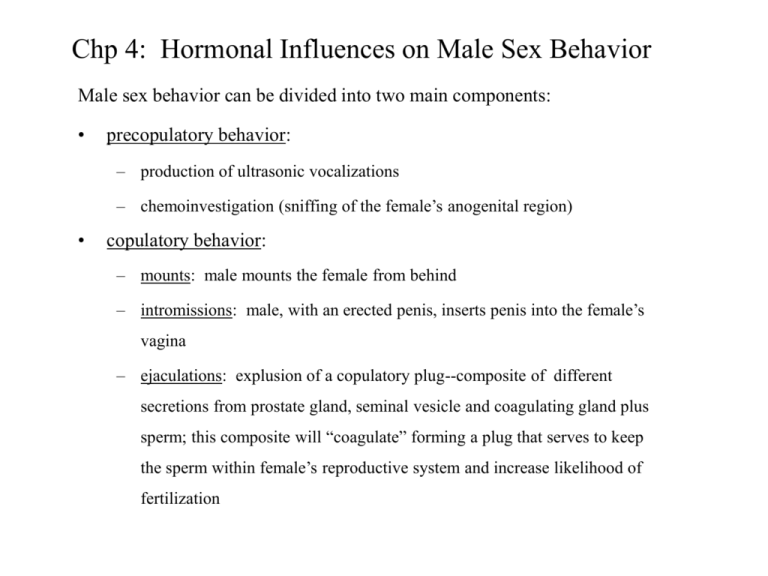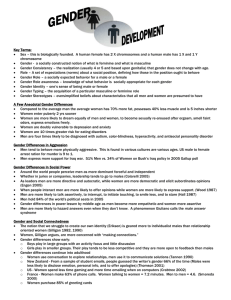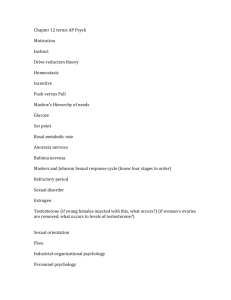
Chp 4: Hormonal Influences on Male Sex Behavior
Male sex behavior can be divided into two main components:
•
precopulatory behavior:
– production of ultrasonic vocalizations
– chemoinvestigation (sniffing of the female’s anogenital region)
•
copulatory behavior:
– mounts: male mounts the female from behind
– intromissions: male, with an erected penis, inserts penis into the female’s
vagina
– ejaculations: explusion of a copulatory plug--composite of different
secretions from prostate gland, seminal vesicle and coagulating gland plus
sperm; this composite will “coagulate” forming a plug that serves to keep
the sperm within female’s reproductive system and increase likelihood of
fertilization
Sequence of Precopulatory and Copulatory Events:
copulation
chemoinvestigation
mount
intromission
ejaculation
(repeated X times)
postejaculatory
interval
(PEI)
satiety
postejaculatory interval (PEI): refractory period following ejaculation in
which male does not engage in sex behavior (seconds to minutes)
satiety: refractory period following a series of ejaculations in which a male
will not engage further in sex behavior with a given female
Quantification of Precopulatory & Copulatory Behaviors:
How to analyze male sex behavior?
•
amount of time engaged in sniffing odors (chemoinvestigation)
•
latency to mount; number of mounts
•
latency to intromit; number of intromissions;
– interintromission interval--length of time between intromissions
•
latency to ejaculate; number of ejaculations
•
postejaculatory interval: length of time from an ejaculation to the next
intromission
Sexual Motivation
In addition to precopulatory and copulatory behaviors, we we can also consider
the male’s desire to engage in sex behavior.
•
Sexual motivation: male’s inclination to seek out and approach a female for
the purpose of mating.
Tests of sexual motivation:
•
latency to mount:
– mount quickly-->really motivated
– mount slowly-->not very motivated
– has problems--??
•
Train a male to press a bar to gain access to a female--how many bar presses
will a male make? (more bar presses=greater motivation)
•
Separate males and females across an electrified grid--how much electrical
current will a male withstand to gain access to a female? (greater current-greater motivation)
Hormonal Influences on Male Sex Behavior
•
In females, transient elevations of estrogen and/or progesterone during the
estrous cycle play an important role in activating female sex behavior.
•
In males, testosterone (and/or its metabolites) also play an important role in
activating male sex behavior.
– Testosterone secretion increases at puberty: development of secondary sex
characteristics, increased muscle mass, production of sperm, and development of
an interest in sexual activity.
– However, testosterone levels do not show similar cyclical changes in levels
reminiscent of the female estrus cycle.
Hormonal Influences on Male Sex Behavior
Testosterone is the major androgen secreted by the testes.
•
aromatization of testosterone to estrogen:
– important for activating male sex behavior in the rat (and in many other species,
although not all)
– involve aromatase and ERs
•
reduction of testosterone to dihydrotestosterone:
– important for penile erections and intromissions in the rat
– involve 5-reductase and ARs
•
testosterone as testosterone::
– important for aspects of sexual motivation
– involve ARs
Testosterone Secretion in Males:
•
GnRH Neuron
-
HYPO
ANT
PIT
•
In interstitial space (testis):
– LH acts at the Leydig cells to
secrete the testosterone
(“steroidogenesis”)
– LH-->increase levels of cAMP
FSH
LH
•
Inhibin
TESTES
– GnRH stimulates release of LH
and FSH from anterior pituitary
+
GnRH
GnRH neurons secrete GnRH
into the median eminence:
Testosterone
GnRH: gonadotropin-releasing hormone
FSH: follicle stimulating hormone
LH: luteinizing hormone
In seminiferous tubules:
– at puberty, FSH and testosterone
act at Sertoli cells to initiate the
production of sperm
(“spermatogenesis”)
– FSH -->increase levels of cAMP
– FSH also stimulates the
production of inhibin from
Sertoli cells which inhibits
release of FSH from anterior
pituitary
Hormonal Influences on Male Sex Behavior
Testosterone is the major androgen secreted by the testes.
•
aromatization of testosterone to estrogen:
– important for activating male sex behavior in the rat (and in many other species,
although not all)
– involve aromatase and ERs
•
reduction of testosterone to dihydrotestosterone:
– important for penile erections and intromissions in the rat
– involve 5-reductase and ARs
•
testosterone as testosterone::
– important for aspects of sexual motivation
– involve ARs
Species Differences: Male Sex Behavior
• In rats (and hamsters):
– estrogen is critical for activating copulation--mounts, intromissions and
ejaculations )
– dihydrotestosterone is critical for penile reflexes
• In some species (lizards, mice &guinea pigs):
– dihydrotestosterone can stimulate male sex behavior
• In ferrets:
– testosterone plays selective role in sexual motivation
• In primates:
– testosterone may also have a selective effect on sex behavior not mediated
by estrogen or dihydrotestosterone
Peripheral Mechanisms:
Androgens are critical for penile erections and deposition of the copulatory plug:
•
androgens stimulate the size and number of sensory receptors on the surface of the
glans penis
•
dihydrotestosterone (DHT) activates penile erections when rats are restrained on
their backs
•
penile erections and deposition of the copulatory plug are controlled (in part) by
motoneurons within spinal nucleus of the bulbocavernosus:
– SNB innervates penile musculature
– DHT acts to increase survival of penile musculature followed by survival of SNB
motoneurons (during development)
– in the adult, DHT also affects the morphology of SNB neurons--increasing size of cell
bodies and increasing length of dendrities
– Note: penile erections and ejaculation are also controlled by the autonomic nervous
system.
Central Mechanisms:
In the male rat:
•
estrogen acts to stimulate copulation--mounts, intromissions and ejaculations
– aromatization is important for this process!
•
MPOA plays an important role the effects of estrogen:
– sexually dimorphic area of the preoptic area (SDA-POA): sexual learning
– dorsal MPOA: critical for stimulation of mounts, intromissions and ejaculations
– dopaminergic inputs--activating mounts, intromissions and ejaculations
•
amygdala plays an important role in facilitating sex behavior--the amygdala
attributes “salience” to cues associated with sex behavior
– corticomedial amygdala--pheromones to activate behavior
– basolateral amygdala--learned responses (e.g., bar pressing to gain access to female)
•
dopaminergic inputs into the nucleus accumbens--sexual motivation
•
dopaminergic inputs into the striatum--general locomotion (e.g., chasing female)
MPOA
In the rat:
•
Aromatization of testosterone to estrogen is important for sexual differentiation of
the brain and activation of male sex behavior.
•
The MPOA is an integrative center for hormonal stimulation of male copulation.
– Large lesions of the MPOA eliminate mounting, intromissions and ejaculations.
– Electrical stimulation of the MPOA stimulates these responses.
– Castrate an adult male rat and he will stop engaging in copulation.
– If you administer testosterone to a castrated male, he will again engage in copulation.
– If you administer testosterone or estrogen within the MPOA (with DHT to act
peripherally), normal male copulation will be seen-->MPOA is critical site!!
•
The MPOA sends projections to neurons within the midbrain and brainstem, which
subsequently project to neurons in the spinal cord; 2 effects take place:
– activation of autonomic centers that control process of erection and ejaculation
– activation of motoneurons that control mounting and pelvic thrusts
MPOA
Anatomical Subdivisions:
•
Study by Heimer and Larsson (1966/67):
– Large bilateral lesions of the MPOA eliminated mating.
•
Study by Arendash & Gorski (1983):
– Is the SDN-POA the critical brain site for control of male copulation?
– No: in sexually experienced males lesions of the SDN-POA had no significant effect on
male copulation.
– Instead, bilateral lesions of the dorsal MPOA produced substantial, long-term decreases
in number of mounts, intromissions, and ejaculations compared to sham-lesioned control
males.
•
Study by De Jonge et al. (1989):
– Revisited role of SDN-POA in male sex behavior--found an effect!
– In sexually naïve males, bilateral lesions of the SDN-POA resulted in an increased latency
to first mount, intromission and ejaculation (took longer to initiate copulation)
– However, this decrement in sexual performance disappeared after repeated testing.
Amygdala:
Corticomedial Amygdala (CMA):
•
CMA: plays an important role in linking pheromones to activation of male sex
behavior
– CMA receives olfactory stimulation from the vomeronasal organ and olfactory mucosa
(sensory structures responsd to odors; project to the olfactory bulbs).
– Pheromones are secreted by female that can stimulate chemoinvestigation and copulation.
– CMA projects to the MPOA.
– Lesions of the vomeronasal organ and olfactory mucosa or bilateral lesions of the CMA
can eliminate male sex behavior--effect is similar to bilateral lesions of MPOA.
Olfactory
Bulbs
CMA
MPOA
brainstem
spinal cord
“Copulatory
reflexes”
Amygdala:
Basolateral Amygdala (BLa):
•
BLa: implicated in associative learning that feeds into motivation circuits.
•
You can train a rat to bar press to gain access to an estrus female.
– If you lesion the BLa, the male rat will not show bar pressing for the female.
– However, if you place the receptive female in the chamber with the male, he readily
copulates with her.
– It is thought that the association between bar pressing to gain access to a female rat (for
copulation) has been lost.
•
The BLa, via connections within the nucleus accumbens, is thought to play a role in
sexual motivation--searching out a female (e.g., bar pressing) in order to mate.
Nucleus Accumbens
The nucleus accumbens (NAcc) has been linked to motivational processes.
•
Mogensen (1980) suggested that the NAcc serves as the “limbic-motor interface”
– a system concerned with translating emotional (“salient”) stimuli into motor output
Limbic System:
Prefrontal Cortex
BLa
“associative
learning”
NAcc
Ventral
Pallidum
MPOA
Motor System:
“Motor Responses”
a) foraging for a female
b) bar pressing for a female
Basal ganglia
Mesencephalic
Locomotor
Region
Central Mechanisms:
In the male rat:
•
estrogen acts to stimulate copulation--mounts, intromissions and ejaculations
– aromatization is important for this process!
•
MPOA plays an important role the effects of estrogen:
– sexually dimorphic area of the preoptic area (SDA-POA): sexual learning
– dorsal MPOA: critical for stimulation of mounts, intromissions and ejaculations
– dopaminergic inputs--activating mounts, intromissions and ejaculations
•
amygdala plays an important role in facilitating sex behavior--the amygdala
attributes “salience” to cues associated with sex behavior
– corticomedial amygdala--pheromones to activate behavior
– basolateral amygdala--learned responses (e.g., bar pressing to gain access to female)
•
dopaminergic inputs into the nucleus accumbens--sexual motivation
•
dopaminergic inputs into the striatum--general locomotion (e.g., chasing female)
Dopaminergic Cell Groups:
Dopamine
Cell Bodies
General Effect
incertohypothalamic
DA cell group
MPOA
ventral tegmental
area (VTA)
nucleus accumbens
mounts, intromissions
and ejaculations
(copulatory reflexes)
display of motivated
behavior
substantia nigra
dorsal striatum
sensorimotor
coordination
(locomotion)
Dopamine
The levels of dopamine increase within these areas during mating:
•
Study by Pfaus et al. (1990):
– in vivo microdialysis was used to follow levels of dopamine (and its metabolites) within
nucleus accumbens and dorsal striatum during copulation
• in vivo microdialysis involves measurement of molecules present in the extracelular space
through diffusion across a semipermeable membrane at the base of a probe implanted into brain
– nucleus accumbens: levels of dopamine increased significantly during placement of a
sexually experienced male in a sex chamber (with odors of prior matings present), with
additional increases observed with placement of a female behind a screen, and then when
the male was allowed to mate with female
– dorsal striatum: levels of dopamine increased significantly only during interaction
between the male and female (copulation)
– concluded: DA released in the nucleus accumbens (from VTA) is involved in motivation
processes (prior to, and in preparation of, the actual act of copulation); DA released in the
striatum is involved in actual physical act of copulation (sensorimotor coordination)
Dopamine
The levels of dopamine increase within these areas during mating:
•
Studies by Hull et al. (1995, 1997):
– in vivo microdialysis was used to follow levels of dopamine (and its metabolites) within
MPOA during copulation
– MPOA: levels of dopamine increased significantly during precopulatory period in which
a female is placed behind a perforated barrier (male can see, hear and smell female but not
mate with her), and then further increases in dopamine occur when the male can interact
with the female
– concluded: DA released within MPOA is involved in sexual motivation (DA is increased
prior to, and in preparation of, the actual act of copulation), and copulatory responses (DA
increases further during the actual act of copulation)
Central Mechanisms--Dopamine
Data from lesions and dopamine release during behavior provide insight into functional
roles of various brain regions to sex behavior:
•
dorsal striatum:
– lesions of dopamine neurons in substantia nigra produce Parkinsonism symptoms:
difficulty initiating movements, slowness of actions and tremor
– DA levels increase significantly during the act of copulation
– dorsal striatum is thought to play a role in sensorimotor coordination (pursuit of female)
•
MPOA:
– lesions of MPOA block display of mounts, intromissions and ejaculations
– administration of DA antagonists into the MPOA can inhibit display of copulation
– DA levels increase prior to, and during, the act of copulating with a receptive female
– MPOA is thought to play a role in both sexual motivation and copulation
– MPOA receives pheromone-associated information from CMA; this information provides
one source of excitatory information linked to both sexual motivation and performance
Central Mechanisms--Dopamine
Nucleus Accumbens (NAcc):
– lesions do not block the display of copulation
– however, blocking input into the NAcc by bilateral lesioning the BLa can block bar
pressing in order to gain access to a receptive female (discussed in terms of sexual
motivation)
– DA levels increase prior to, and during, the act of copulating with a receptive female
– however, DA levels also increase in NAcc in response to feeding, drinking, drug selfadministration
– Nacc is thought to play a role motivational processes and reward
Hormonal Regulation
Testosterone, and/or its conversion to estrogen, is important not only for stimulating
copulation but also for motivational processes.
If you train a male to bar press to gain access to a female, you can study the effects of
specific brain lesions and compare those effects to that produced by castration.
Sexual performance:
•
bilateral lesions of the MPOA, but not BLa, eliminate copulation (low % of rats
engaged in copulation)
•
castration also dramatically decreases % rats copulating
Motivation processes:
•
bilateral lesions of the BLa, but not the MPOA, greatly reduce bar pressing to gain
access to a receptive female
•
castration also dramatically decreases bar pressing
Hormones and Dopamine Regulation
Does castration alter dopaminergic neurotransmission to effect changes in male sex
behavior? Answer--yes, testosterone facilitates dopamine release!
Studies by Alderson & Baum (1981); Mitchell & Stewart (1989):
•
castration decreases the level of dopamine within the nucleus accumbens
•
administration of testosterone, or estrogen plus dihydrotestosterone, increases
dopamine levels within this nucleus
Study by Hull et al. (1997):
•
castration decreases release of dopamine within the MPOA in response to a
precopulatory period (female behind barrier) or interactions with an estrous female
•
some castrates (1 week) showed dopamine release in MPOA and engaged in sex
behavior (short-term response; eventually all castrated males will stop mating)
•
administration of testosterone proprionate restored release of dopamine within
MPOA in response to precopulatory period and facilitated mating
Opioid and Male Sex Behavior
Opioids have been shown to inhibit male sex behavior.
Study by Hughes & colleagues (1988):
•
infusion of B-endorphin into the medial preoptic area causes a reduction in male’s
mating performance
•
infusion of naloxone, an opioid receptor antagonist, can facilitate sexual
performance and block inhibitory effect of B-endorphin
MPOA
male
copulation
Arcuate
Nucleus
naloxone
B-endorphin
neurons
Opioid and Male Sex Behavior
Opioids have been shown to stimulate male sex behavior.
Mehrara and Baum (1990):
•
Design:
– conditioned place preference is a test of motivation (desire to spend more time on one side
of a chamber than the other)
– established conditioned place preference in male rats given the opportunity to mate on
only one side of the chamber
– how much time would the males spend on the side of the chamber in which they had
mated
– several variables: 1) sham-operated vs. castration, 2) given naloxone at varying doses or
saline, and 3) testing the animals 7 days after surgery or 14 days
Opioid and Male Sex Behavior
Opioids have been shown to stimulate male sex behavior.
Mehrara and Baum (1990):
•
Results:
– administration of naloxone decreased time spent in the chamber associated with mating
(e.g., loss in conditioned place preference)
– administration of naloxone also decreased time spent in the chamber associated with
mating in males 7 days after castration, but not 14 days, after castration
•
Conclusion:
– opioids act to facilitate conditioned place preference (blocking opioid activity can
blockthis response)
– the ability of opioids to facilitate conditioned place preference is lost at 14 days
postcastration
– opioids act to stimulate dopamine release from neurons within the VTA; dopamine
neurons in VTA project to NAcc; NAcc is involved in motivational processes
Opioid and Male Sex Behavior
Opioids have been shown to stimulate male sex behavior.
opioids
Nucleus Accumbens
VTA
+
+
Motivation
(e.g., conditioned
place preference)
dopamine
neurons
Neurons & Behavior
How to study role of specific groups of neurons in specific behavioral responses?
•
compare the behavior of lesioned animals to sham-operated controls
– lesions can be made with electrical current (electrolytic) or with neurotoxins
(neurochemical)
•
compare the behavior of different groups of animals following the administration of
drugs that either increase or decrease the level of a specific neurotransmitter:
– lesion specific neurons: 6-hydroxydopamine is used to lesion dopamine neurons
– use agonists to stimulate activity at specific receptors
– use antagonists to block activity at specific receptors
•
follow the activation of groups of neurons at various endpoints of behavior:
– release of neurotransmitters
– expression of molecules that serve to “mark” activated neurons
• expression of c-fos proto-oncogene
c-fos Expression
c-fos expression is used as a marker of neuronal activation:
•
levels of c-fos mRNA and Fos protein are low in control, unhandled animals
•
if you stimulate an animal--handling, mating, stress, etc., you will see significant
increases in the level of these molecules
•
the rise and fall occurs quickly:
– c-fos mRNA peaks by 30-60 minutes, and declines to basal levels within 2 hours
– Fos protein peaks by 1-2 hour,s and declines to basal levels within 4 hours
•
the transient nature of c-fos expression as well as the low levels basally enables
detection of these molecules to serve as a “marker” of neuronal activation
•
c-fos expression serves to couple “inputs” (neuronal or hormonal) with gene
transcription:
– Fos protein forms a dimer with Jun protein--called “AP-1” factor
– AP-1 factor binds to specific DNA sequences (AP-1 site) to control transcription of genes
Components of Mating
Kollack-Walker & Newman (1997):
•
Experimental Design:
– sexually experienced male hamsters were exposed to female hamster vaginal secretion
(FHVS) for 10 minutes, or allowed to mate to different endpoints of copulation: 5
intromissions, 1 ejaculation, 5 ejaculations, long intromissions
– long-intromissions: characterized by a period of extended intravaginal thrusting during
which no sperm transfer occurs; the occurrence of long intromissions is believed to reflect
a state of sexual satiety (turning off male sex behavior)
– following FHVS exposure or copulation, males were kept in the mating arena (up to one
hour) until they were anesthetized, perfused with fixative, their brains removed from the
skull and sectioned on a freezing microtome
– a series of sections from each animal were processed for Fos immunocytochemistry
– the number of Fos-immunoreactive neurons were determined for specific brain regions in
each animal, averaged per group, and compared statistically
Components of Mating
Kollack-Walker & Newman (1997)
•
Results:
– significant patterns of activation were observed within medial amygdala (MeA), bed
nucleus of the stria terminalis (BNST) and medial preoptic area (MPOA) following:
FHVS exposure alone, mating to 1 ejaculation, and mating to multiple ejaculations
– in particular, neuronal cell “clusters” in the caudal part of the posterior medial nucleus of
the amygdala (cMePD) were seen in 67% of males mating to 5 ejaculations, and in 100%
of males mating to long intromissions
•
Conclusion:
– different patterns of c-fos expression were observed in males that engaged in different
levels of sexual activity (chemoinvestigation, copulation)
•
Question: Does the selective pattern of neuronal activation seen following multiple
ejaculations reflect a state of satiety or simply a phenomonon of experiencing
multiple ejaculations?
Sexual Satiety
Parfitt & Newman (1997)
•
Experiment #1: Do the number of ejaculations prior to the occurrence of long
intromissions make a difference in the pattern of c-fos expression?
•
Design:
– compare pattern of Fos-immunostaining within sexually experienced male hamsters mated
to long intromissions in 2 groups: 1) rested male hamsters (rested 1 week), and 2) male
hamsters mated to long intromissions on 4 consecutive days prior to experimental day
– rested male hamsters show more ejaculations (on average 9 ejaculations) while repeatedly
mated males show fewer ejaculations (on average 4 ejaculations)
•
Results: (focus on neuronal cell “clusters” in cMePD)
– males mated to long intromissions in both groups (rested male hamsters and repeatedly
mated male hamsters) showed the presence of neuronal cell clusters in cMePD
•
Conclusion:
– the number of ejaculations does not alter presence of neuronal cell“clusters” in cMePD
Sexual Satiety
Parfitt & Newman (1997)
•
Experiment #2: Does mating to only 1 ejaculation produce different patterns of
neuronal activation in males that differ in their proximity to sexual satiety?
•
Design:
– compare pattern of Fos-immunostaining within sexually experienced male hamsters mated
to only one ejaculation in 2 groups: 1) rested male hamsters (rested 1 week), and 2) male
hamsters mated to long intromissions on 4 consecutive days prior to experimental day
•
Results: (focus on neuronal cell “clusters” in cMePD)
– following mating to only 1 ejaculation, repeatedly mated males showed the presence of
neuronal cell “clusters” within cMePD, while the rested males did not
•
Conclusion:
– the number of ejaculations are not critical for the occurrence of neuronal cell “clusters”
within cMePD, rather the proximity to satiety was the critical factor
– neuronal cell “clusters in cMePD may reflect development of a state of satiety!
The Coolidge Effect
The Coolidge Effect:
•
males recently mated with a particular female appear uninterested in further
copulation (sexual satiation)
•
however, if a new female is introduced, then the male will continue to mate
•
thus, the introduction of novel females can extend a male’s sexual motivation and
performance
Sexual Satiety
Summary:
•
different patterns of c-fos expression are observed in male hamsters mated to
different endpoints of copulation--female odors, 1 ejaculation and multiple
ejaculations
•
neuronal cell “clusters” in cMePD: their appearance is dependent upon how close a
male is to sexual satiety
– clusters are present in all males mated to long intromissions (LI)
– clusters are present after only 1 ejaculation in repeatedly mated males (4 ejaculations
away from LI) but not in rested males (9 ejaculations away from LI)
•
thus, neuronal cell “clusters” in cMePD may reflect development of a state of satiety
•
in the literature, there is evidence that lesioning this part of the medial amygdala in
female hamsters can produce a significant increase in the duration of copulation
[Takahashi & Gladstone (1988) Behav. Neurosci., 102: 268-275]
Seasonality in Reproduction
•
Seasonal breeders: engage in sexual activity during certain times of the year.
•
Reproductive axis also varies with the breeding season.
During Breeding Season
Out of Breeding Season
GnRH
GnRH
LH & FSH
LH & FSH
testes
testes
testosterone
testosterone
Display of sex behavior
No display of sex behavior
•
Seasonal breeders: hamsters, sheep, deer, zebra finches, ferrets
•
Nonseasonal breeders: rats, humans, primates
•
Similar events within the reproductive axis are observed in males and females of
species that are seasonal breeders.
Seasonality in Reproduction
•
The breeding season for different species varies, and is dependent upon an
interaction between environmental factors and length of gestation.
•
Environmental factors: food availability, temperature--signaled by changes in day
length (photoperiod).
•
Goal: ensure that the offspring are born under conditions optimal for their survival.
Ex. Sheep
Ex. Ferrets
Breeding season in fall
Breeding season in spring
Daylength is decreasing
Daylength is increasing
Gestation period: 5 months
Gestation period: 41 days
Newborn lambs will be born
in spring
Newborn ferrets will be born
in spring
Seasonality in Reproduction
•
Seasonality can affect how the brain responds to gonadal steroids:
house under
short day
photoperiod
male
hamsters
castrate
replace
testosterone
house under
long day
photoperiod
•
How well does administration of exogenous testosterone restore male sex
behavior?
•
Testosterone is most effective in stimulating male sex behavior in males housed
under long day photoperiod compared to males housed under short day
photoperiod.







